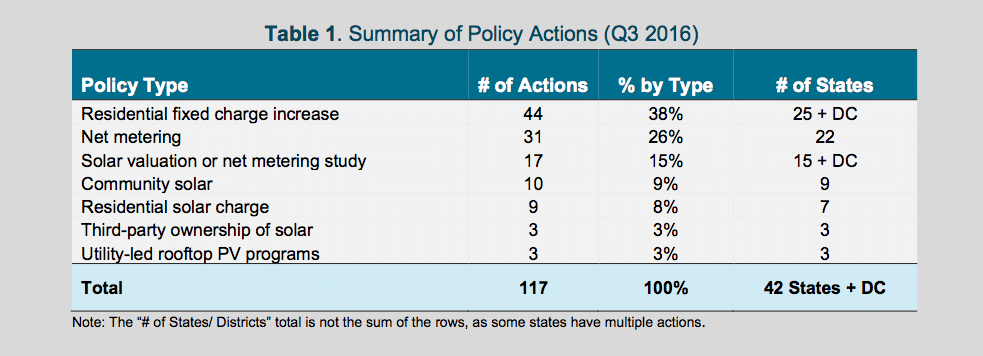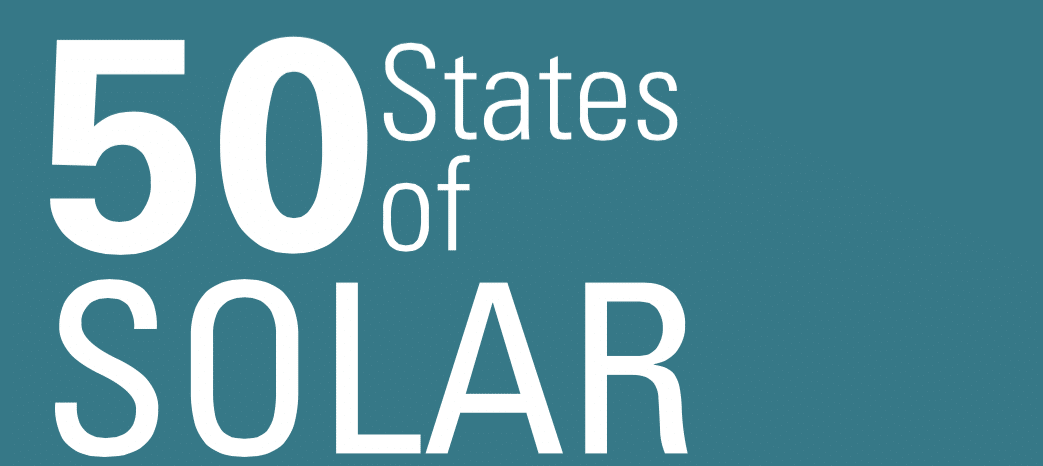The NC Clean Energy Technology Center (NCCETC) released its 50 States of Solar: Q3 2016 Quarterly Report today, and it documents 117 separate attempts by states to change laws affecting solar policy.
Broadly, the changes occurred in seven categories (in order of frequency):
- Residential fixed-charge increase
- Net-metering
- Solar-valuation or net-metering studies
- Community solar
- Residential solar charges
- Third-party ownership of solar
- Utility-led rooftop PV programs

The report, compiled by Autumn Proudlove, Kate Daniel, Brian Lips, David Sarkisian and Achyut Shrestha, highlighted a significant shift in fixed-charge decisions — and it wasn’t in a good direction for solar.
Q3 saw 100% of requests (44) granted, at least partially. And the increases were significant — the average increase for utilities was 53 percent (with a mean of 37 percent).
In contrast, more than half of similar requests were refused in Q2.
Not surprisingly, changes to net-metering were the second-most-common action taken by the states. Utilities continued their crusade to alter significantly or eliminate entirely the credit rates they have to pay to solar customers who export solar electricity to the grid. Currently, 11 states are considering rate changes, up from seven last quarter.
Community solar, one of the fastest-growing solar markets in the United States, became a focus of utilities in Q3, with several states moving toward a more granular approach to customer charges. While most programs are structured so subscribers receive retail-rate per kWh credits on their bills, one state proposed time-of-use rates, and another wants to institute ever-elusive “value-of-solar rates.”
Lastly, demand charges remain on the dockets of many utilities, though investor-owned utilities have not made the majority of requests. As the report notes, two of the most recent proposals for demand charges applied to all customers instead of solely applying to residential customers.
The report also highlighted the top five solar policy developments in Q3 2016, including:
- The Arizona Corporation Commission’s (ACC) decided to approve an increase in a residential fixed charge, but delayed changes to demand charges and net-metering proposals until the state decides its broader value-of-distributed-generation (DG) proceeding. The delay will also allow November’s elections to be completed. Two of the five ACC commissioners are up for election.
- Nevada’s Public Utilities Commission’s (PUCN) decided to grandfather net-metering customers that installed systems by Dec. 31, 2015. The decision followed on the heels of their decision in December 2015 to reduce net-metering rates, which didn’t originally include the grandfathering provision. Gov. Brian Sandoval’s New Energy Industry Task Force recommended the legislature restore retail net metering with a $25 minimum bill until the PUCN decides on a comprehensive “value of solar” compensation mechanism. The Nevada legislature will reconvene on Feb. 6, 2017 and conclude on June 6.
- The Arkansas Public Service Commission (APSC) will launch an investigation into whether the state’s net-metering policies shift undue costs to non-solar customers. The results of the study would be used to decide whether changes need to be made to current net metering.
It should be noted that sixteen states have commissioned cost-benefit analyses on whether having solar consumers on the grid has a negative effect on non-solar customers (the list misses the studies in South Carolina, Mississippi and Louisiana). Only one study has given even the hint that ratepayers are harmed (Louisiana), and that study was done by a firm so closely tied to the fossil-fuels industry as to be easily discounted.
- Instead of implementing grid-access charges as it requested, Xcel Energy Colorado will implement a pilot program for time-of-use rates for residential customers.
- Significantly, the National Association of Regulatory Utility Commissioners issued a draft of its distributed-energy-resource (DER) compensation manual in July. It provides guidance for regulators across the country as they consider rate design.
The NCCETC report considered policy changes of investor-owned utilities and large publicly-owned or nonprofit utilities that served at least 100,000 customers.
This content is protected by copyright and may not be reused. If you want to cooperate with us and would like to reuse some of our content, please contact: editors@pv-magazine.com.








By submitting this form you agree to pv magazine using your data for the purposes of publishing your comment.
Your personal data will only be disclosed or otherwise transmitted to third parties for the purposes of spam filtering or if this is necessary for technical maintenance of the website. Any other transfer to third parties will not take place unless this is justified on the basis of applicable data protection regulations or if pv magazine is legally obliged to do so.
You may revoke this consent at any time with effect for the future, in which case your personal data will be deleted immediately. Otherwise, your data will be deleted if pv magazine has processed your request or the purpose of data storage is fulfilled.
Further information on data privacy can be found in our Data Protection Policy.